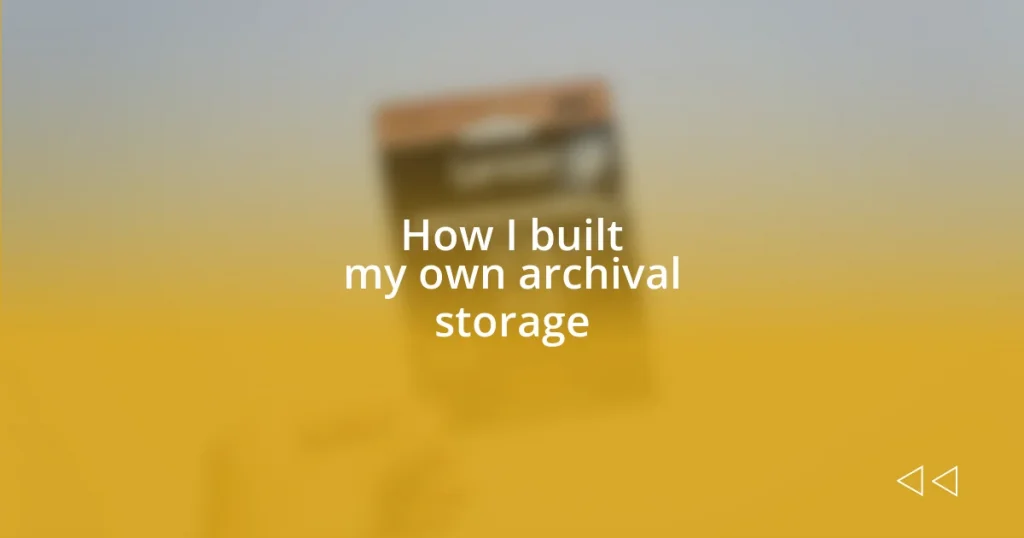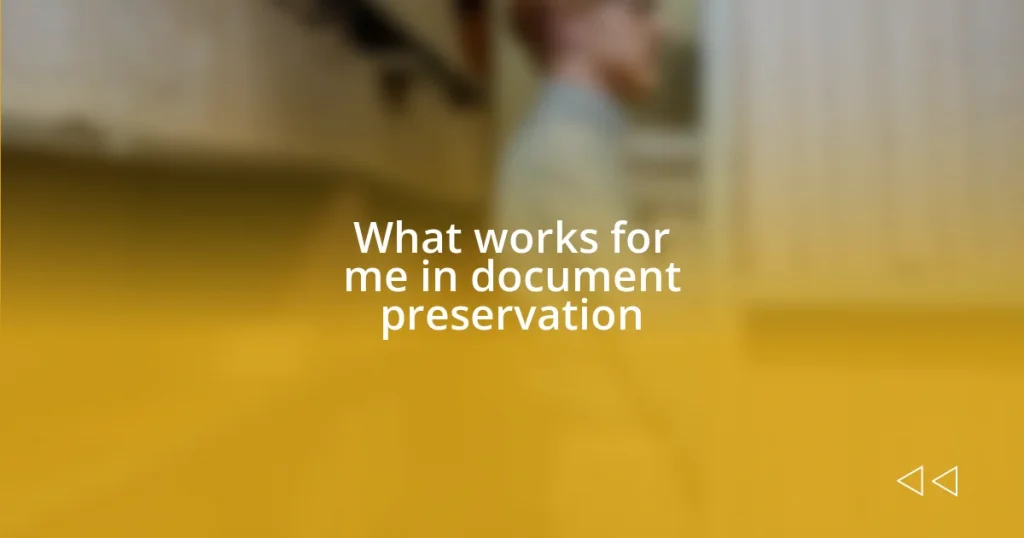Key takeaways:
- Assessing archival needs involves understanding the materials that require preservation, ensuring proper environmental conditions, and anticipating future expansions.
- Choosing archival-quality materials, such as acid-free boxes and protective sleeves, is essential for safeguarding items and preventing deterioration.
- Implementing effective labeling, maintaining environmental controls, and regularly updating storage practices are vital for long-term preservation and accessibility of archival collections.

Understanding archival storage needs
When I first started thinking about my archival storage needs, I realized how crucial it is to assess the type of materials I wanted to preserve. For instance, photographs that meandered through my family history demanded a different kind of care than documents. Have you ever held an old photo—one that tells its own story? That’s the kind of moment I wanted to cherish, which meant ensuring appropriate conditions for both temperature and humidity.
Choosing the right storage solutions often felt overwhelming. I remember standing in front of countless boxes at my local craft store, wondering which ones would truly safeguard my treasures. What I learned is that not only do materials need to be archival-quality, but the organization of those materials can significantly impact their longevity. Sort them in a way that makes sense to you—maybe chronologically or by theme—and you’ll find that accessing them later becomes a joy rather than a chore.
I also found it essential to consider my future needs. Will I add more items down the line? Do I have enough space to expand? Reflecting on these questions helped me create a flexible storage system that could evolve. It’s like planting a tree: if you anticipate its growth, you’ll cultivate a healthier, more sustainable environment for it to thrive.
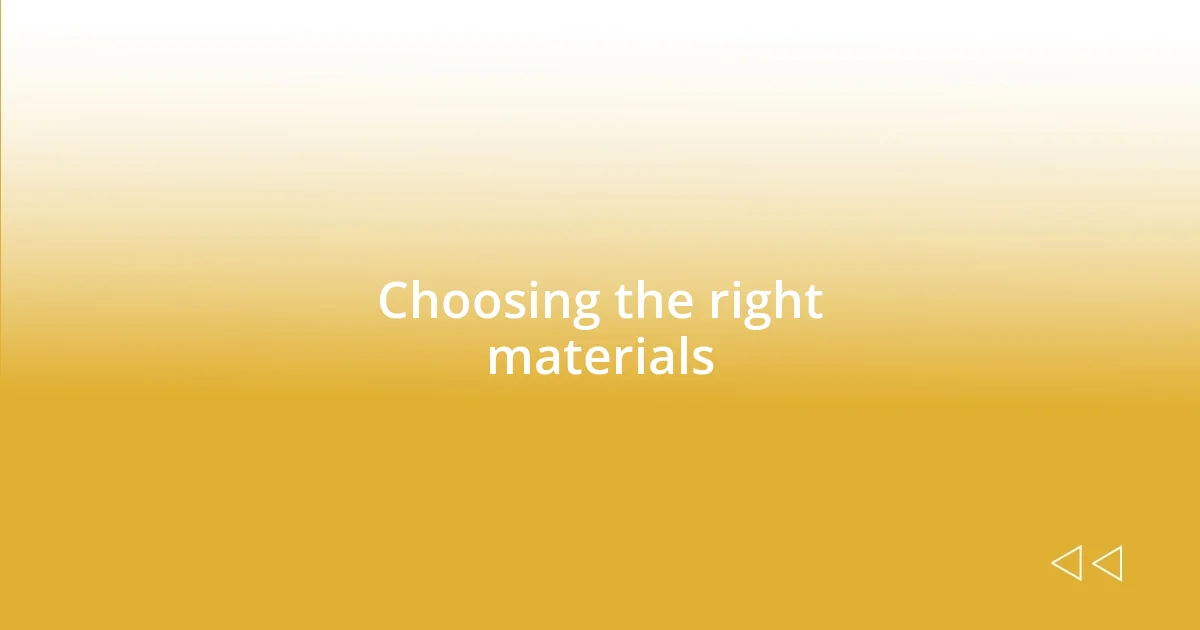
Choosing the right materials
When I began selecting materials for my archival storage, it was like piecing together a puzzle. The first thing that struck me was the importance of acidity levels. I vividly recall picking up a box labeled “acid-free” at the store, feeling an immediate sense of relief wash over me. This simple aspect can make a world of difference in preserving delicate items, especially if they hold significant emotional value.
Here’s a quick checklist of materials I found helpful in my journey:
- Archival-quality boxes: Look for acid-free materials to prevent degradation.
- Protective sleeves: Use polyethylene or mylar for photographs and documents.
- Labeling supplies: Acid-free labels help in organizing without causing damage.
- Humidity control packs: Consider using silica gel packets to maintain a stable environment.
- Tissue papers: Acid-free tissue helps to cushion and protect fragile items.
Ultimately, I learned that investing in these quality materials not only safeguards my collection but also gives me peace of mind. The joy of knowing that I’m preserving memories for future generations makes every bit of effort worthwhile.

Designing an effective layout
Designing an effective layout for my archival storage turned out to be much more than a logistical task; it became a creative endeavor. I remember sketching out my ideas on paper, envisioning a space where each item had its place, almost like a well-curated museum. The thought of wandering through my collection, easily finding treasures from my past, filled me with excitement. It’s essential to consider not only what fits where, but how easy it will be to access and enjoy these pieces later.
As I dove deeper, I realized that vertical space is often underutilized. By incorporating shelving, I created a three-dimensional layout that maximizes storage without overcrowding. Using clear bins allowed me to see everything at a glance, eliminating the dreaded “lost within the stacks” feeling. Have you ever spent an hour rummaging through boxes only to realize you were looking in the wrong one? I wanted to avoid that frustrating experience, so I organized items by categories and added labels that made sense to my unique collection.
Lastly, I believe flexibility should be a cornerstone of any archival layout. Events in life can shift our needs and collections grow unexpectedly. For instance, after discovering a box of letters from my grandparents, it became clear that I needed to create extra space. I designed my shelves with adjustable racks, making them versatile for both current and future items. It’s a good reminder that when you take the time to design with intention, you can create a system that evolves with you.
| Aspect | Considerations |
|---|---|
| Space Utilization | Incorporate vertical shelving for better organization. |
| Accessibility | Use clear bins and labels for easy identification. |
| Flexibility | Design with adjustable racks to accommodate future growth. |
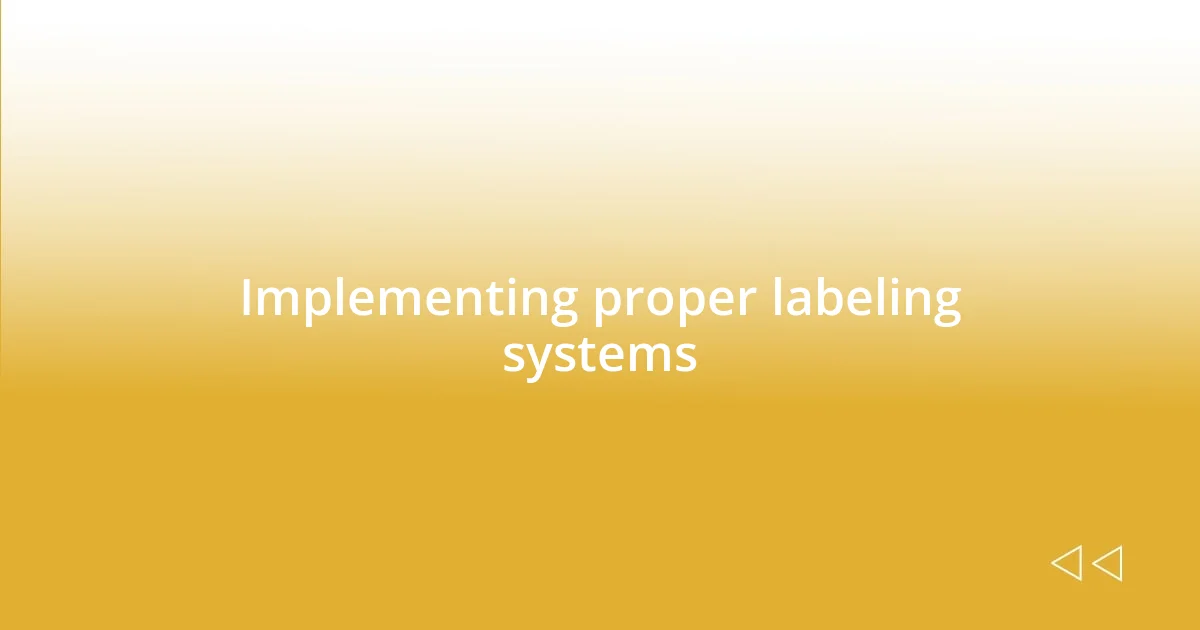
Implementing proper labeling systems
Implementing a proper labeling system has been one of the most transformative steps in my archival storage project. I recall the day I came across a pack of acid-free labels; it was like finding an essential key to my organizational puzzle. Each label I created was not just a marker but a small guide, telling the story of the item’s origin and significance. Have you ever mixed up cherished memories because they weren’t labeled correctly? Trust me, it’s a frustrating experience I wanted to avoid at all costs.
I quickly learned that consistency is key in labeling. I used a uniform format for each label, including relevant details like the date and a brief description. This approach not only streamlined the process but made my collection visually appealing as well. It feels so rewarding to open a box and instantly recognize what’s inside. The sense of satisfaction that comes from this clarity is something I wish I’d discovered sooner!
Interestingly, I opted for color-coded labels for different categories, which was an unexpected yet delightful twist in my journey. This simple visual cue allowed me to quickly identify groups – family photos, important documents, and sentimental keepsakes – without digging through each box. It’s fascinating how a little color can brighten up your storage area while serving a practical purpose. In my experience, when you enjoy the process of organizing, it doesn’t feel like a chore; it becomes an engaging way to reconnect with your past.

Ensuring environmental control
Ensuring environmental control was one of the most crucial aspects of my archival storage project. I once had a heart-wrenching experience with a box of irreplaceable photographs that suffered water damage due to humidity. That incident made me realize that controlling the environment was about more than just aesthetics; it was about preserving my memories. Implementing a dehumidifier and monitoring the temperature was essential for keeping everything safe.
I found that using acid-free materials for storage made a noticeable difference in protecting my items. It’s remarkable how those simple choices can shield your treasures from deterioration. I remember carefully selecting acid-free folders and boxes, feeling reassured knowing my cherished mementos were better guarded. Have you ever held onto something so precious that it felt like a piece of your soul? That’s how I felt about my collection, and I wanted to ensure it lasted for future generations.
Lighting became another important factor for me. I had once heard a horror story about sunlight fading a beautiful vintage dress, and I had no intention of letting that happen to my collection. I decided to utilize low-UV LED lighting, which not only created a soft glow but also protected my items. The gentle lighting added an inviting ambiance to my space, and even transformed the act of accessing my collection into a rewarding experience, making me feel like I was in a personal gallery rather than just a storage room. How wonderful is it when we can turn something practical into a passion?
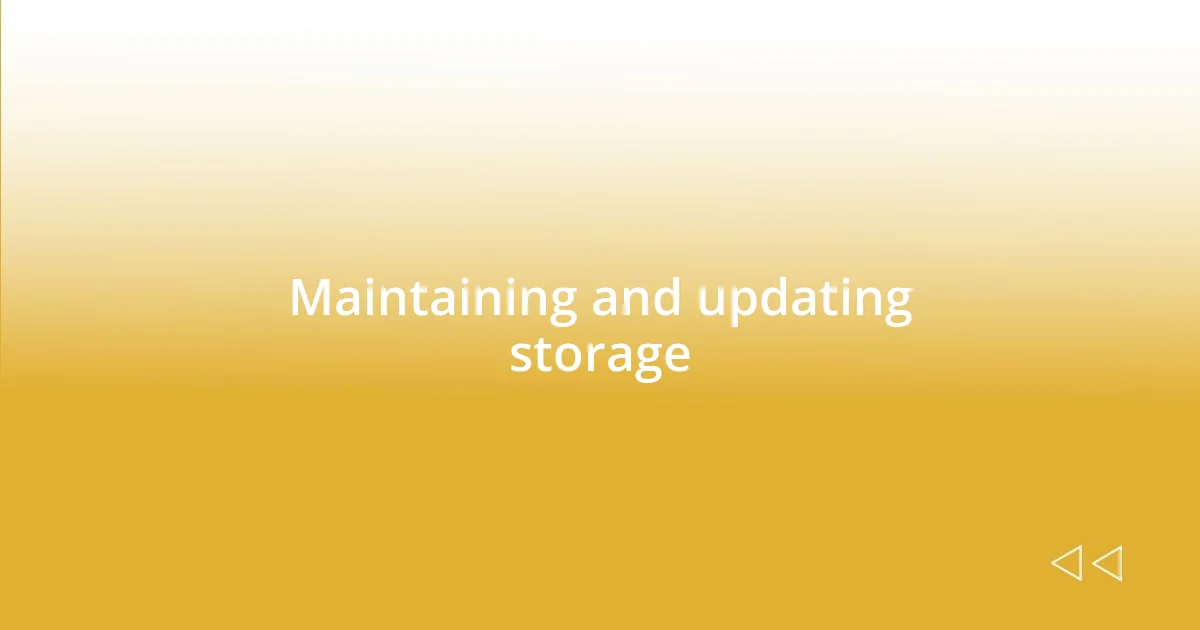
Maintaining and updating storage
Maintaining and updating my archival storage goes beyond just initial setup; it’s become a regular part of my routine. I remember my first spring cleaning session, where I found myself sifting through old documents and rediscovering forgotten memories. As I organized, I made it a point to reassess what items were truly essential and which could be safely scanned and digitized. Have you ever realized that some things weigh you down more than others? That’s exactly how I felt as I streamlined my collection, making it lighter and easier to manage.
Alongside decluttering, I set aside time each year to review my labeling system and environmental controls, ensuring everything remains relevant and effective. During one of these reviews, I noticed a few labels had faded or gotten lost—an unexpected reminder of the wear time can inflict. I decided to create a digital backup of my labels as a precaution, which not only preserves the information but adds a modern twist to my archival process. Isn’t it fascinating how even a small update can breathe new life into an existing system?
Finally, I prioritize regular checks of my storage conditions, monitoring humidity and temperature like a guardian of my treasured items. There were moments when I found myself anxiously checking the dehumidifier’s readings after a heavy rain—what if my fears materialized again? It’s a constant balancing act between preservation and peace of mind. Reflecting on this, I often think about how vital it is to be proactive. After all, safeguarding memories is not a one-time act but a lifelong commitment that fills my heart as much as it organizes my space.

Best practices for archival longevity
I’ve learned that keeping a consistent check on the storage conditions is essential for my archival items. One Friday night, I found myself glued to the readings on the hygrometer, worried that a hot summer day had tipped the scales in favor of humidity. It’s almost surprising how just a small spike could alter the environment—that tension between safeguarding my memories and trusting the equipment I’d set up became my new form of meditation. Have you ever felt that knot in your stomach when protecting something you love? That sensation has turned me into a diligent caretaker.
Furthermore, ensuring proper handling of my materials has been a game-changer. I remember the heart-stopping moment when I accidentally brushed my fingers against a delicate vintage postcard—my mind raced with worry over potential oils or dirt from my hands. I quickly invested in gloves and made a habit out of using them whenever I interact with my collection. This simple act not only gives me peace but also enhances my appreciation for the items, creating an unspoken connection as I treat them with the reverence they deserve. How often do we rush through interactions without being fully present? This practice has reminded me to slow down and truly engage with my archival treasures.
Lastly, I cannot stress enough the impact of regular updates on my archival practices. For instance, during last year’s organization, I stumbled upon some old cassette tapes filled with family music. It was a bit disheartening to realize they were fading, so I prioritized digitizing them as a way to preserve both the audio and those cherished memories. I found it fascinating how transformation can bring so much joy and safety to my collection. Taking proactive steps to evolve my archiving methods often makes me reflect on my past. Isn’t it incredible how every small adjustment builds a bridge between memories and future generations?










